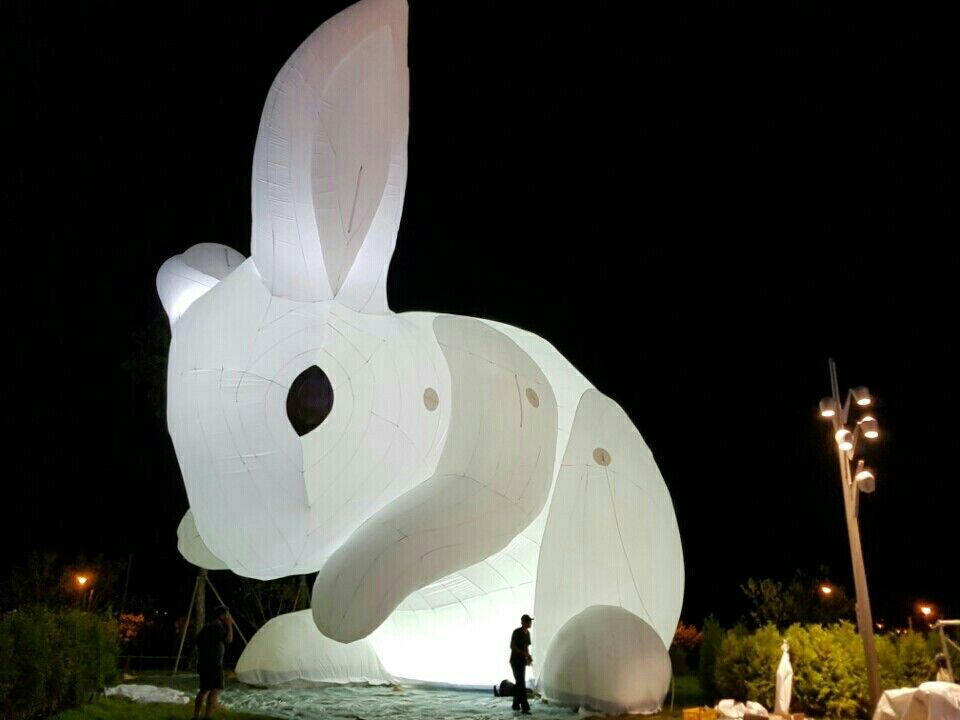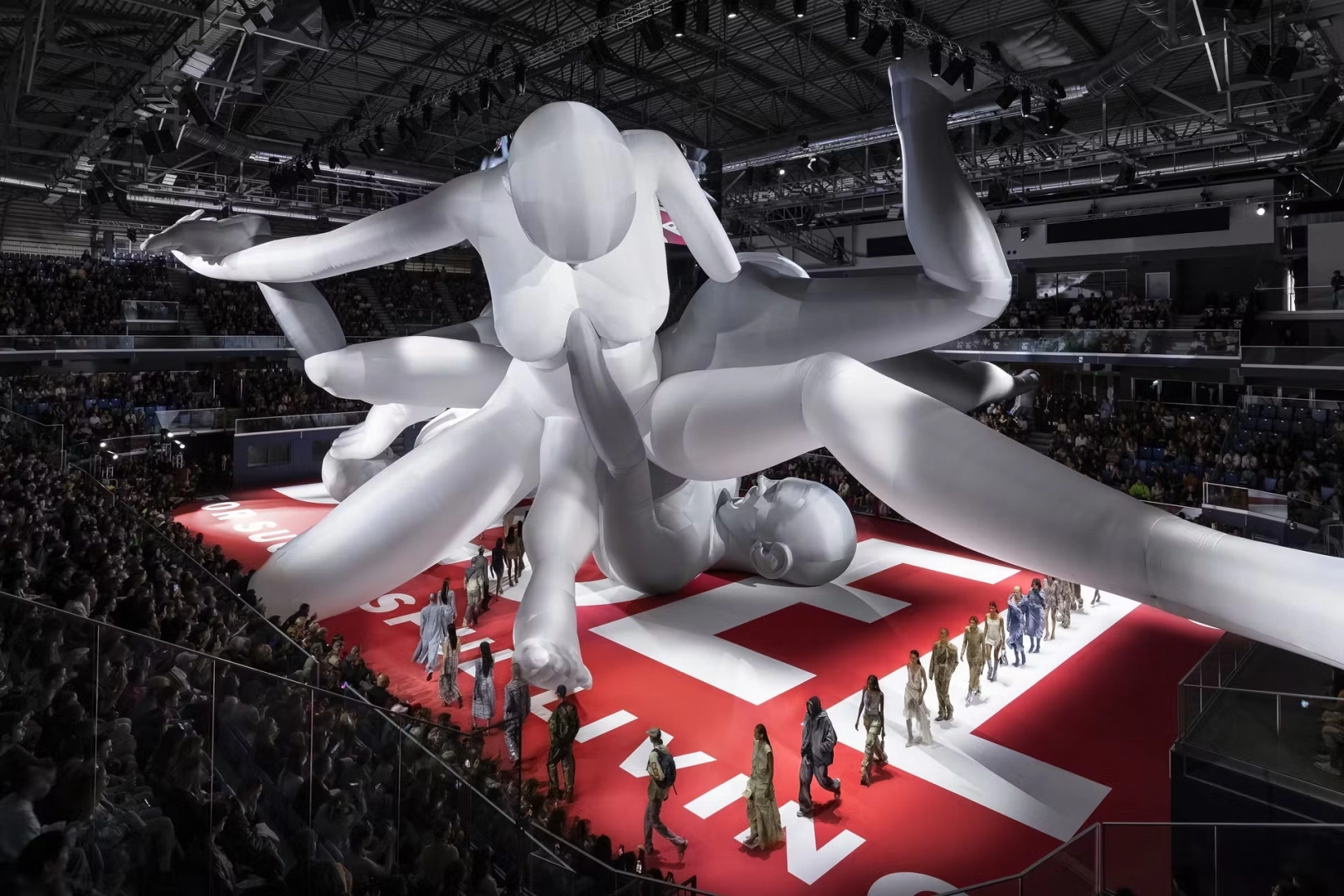A sculpture inflated to enormous proportions exploring the limits of the human body appeared at the end of last year in Milan during Diesel fashion show. Inflatable sculptures of many shapes and sizes are created by artists all over the world and quite a few are associated with sports events, too. Among such works is e.g. a huge jersey of Argentina's local star Lionel Messi, which was created on the occasion of the country's victory at the recent FIFA World Cup. The art festival preceding the Olympic games had a huge head flying over Tokyo. Canadian Max Streicher even based his entire work on inflatable sculptures. When it comes to sports, he mostly touches upon swimming; whether it's an intervention in a swimming pool or huge figures of swimmers floating in the air.
The statue exhibited in the Allianz Cloud Arena in Milan on September 21 has officially become the largest inflatable sculpture entered in the Guinness Book of Records. The record-holding sculpture was 50 meters long, 38 meters wide and 14 meters high. It was made of parachute nylon and captured four bodies with their limbs intertwined so much they seem to merge into each other.
.jpg)

The sculpture for the show of the Italian fashion brand Diesel was created by the Dutch design office Studio Dennis Vanderbroek. They found inspiration not only on ancient statues, but also in extreme sports and often almost unbelievable performances of dancers. To create this sculpture exploring the physical limits of a human body, the designers used a 3D modeling method.
Huge sculptures complemented the FIFA World Cup and the Olympics
Another record is connected to the last football World Cup. The world's largest inflatable football jersey celebrates the victory of Argentina's team and especially its captain Lionel Messi. Colombian artist Alejandro Uribe created a huge inflatable T-shirt which reaches about 20 meters in height and 17 meters in width. The giant garment was made of biodegradable plastic. People can even enter the inside of this sculpture, and the author even let children celebrating Messi's victory to play football inside. This jersey aspires to enter the Guinness Book of Records as well.

Inflatable sculptures also came about in connection with the last Olympics in Tokyo, when the Games themselves were preceded by an art festival. Only days before the opening of the Olympic Games, a giant head appeared above Tokyo, hovering over the roofs and parks of the city. This huge balloon with a real human face depicted on it bore the name Masayume, which is Japanese for "a dream come true". The inspiration for its creation was an actual dream of one of the artists from the art collective Mé, who also authors this artistic response to the Olympic Games. A huge inflatable runner also appeared in Moscow during the 2013 World Athletics Championships.

Max Streicher's inflatable statues are not limited to Toronto's public spaces
An artist whose work is based on inflatable sculptures is Canadian Max Streicher. He does’t depict specific athletes, but rather captures various positions or movements. For example, his statue Floating Giants depicts enormous bodies of swimmers who, of course, don't swim in water but in the air. The seven-meter-tall figures complemented by globes of different sizes were exhibited in Toronto in 2006.


Another time he worked with a swimming pool area, where he installed a massive inflatable cloud above the water surface. Cloud was placed e.g.in the University of Toronto swimming pool, but the artist uses their ability to repeatedly deflate and inflate and keeps installing them in different locations. His other works portray, among others, a four-seater, a clown, a huge baby or people in various intertwined positions. All these sculptures made of nylon, vinyl or Tyvek are connected by their lightness, which allows them to react to the movements of air and so to speak come alive.
Inflatable sculptures are gaining popularity all over the world
In 2018, San Francisco hosted an exhibition focused solely on inflatable art. It was curated by Christopher Jobson, the editor-in-chief and co-founder of the art and design website Colossal. The group exhibition Inflatable brought together five artists whose art works are filled with air. Among them were Jason Hackenwerth and his spacious abstract structure or Jimmy Kuehnle, who let visitors wander through a forest of pillow-like cylinders. Taiwanese artist Shih Chieh Huang then created a remarkable sculpture combining garbage bags with LED light technology, thanks to which he delivered a colorful spectacle named Guardian of the Disphotic. For the exhibition, a design collective exhibiting under the name Pneuhaus created a large dome composed of 109 inflated parts, each of which employ the principle of camera obscura.

.jpg)
Last but not least, the exhibition was also attended by large white figures of Amanda Parer. The Australian artist keeps revisiting inflatable art; in the past she also created a series of seven-meter tall, white inflatable rabbits which were glowing at night. She responded to the strange contradictory attitudes to this animal, which is on the one hand considered a cute pet, but in her native Australia it poses a serious threat to local nature.
An interesting, site-specific use of inflatable sculptures was brought to Philadelphia in 2018 by an anonymous group of local artists who call themselves Group X. A pop-up inflatable installation titled Sea Monsters HERE revived an abandoned shipyard building. The authors of the inflatable tentacles are recognized artists Filthy Luker and Pedro Estrellas, who have been creating inflatable objects designated for public space for 23 years. Their tentacles have appeared all over the world, for example in Berlin, where they run a street art museum, in Bordeaux, Dublin or Bristol and they also stand behind other funny elements, such as eyes or brushes, which keep popping up on the streets.


